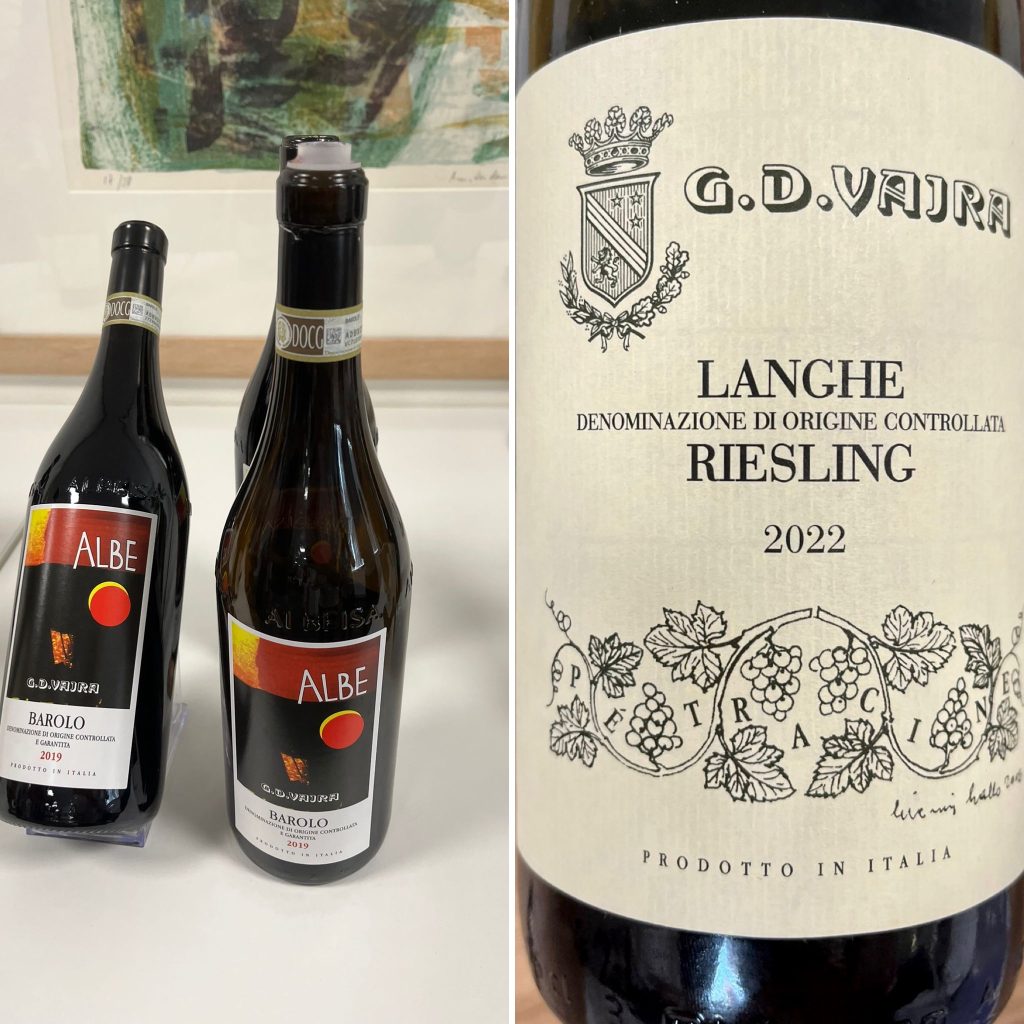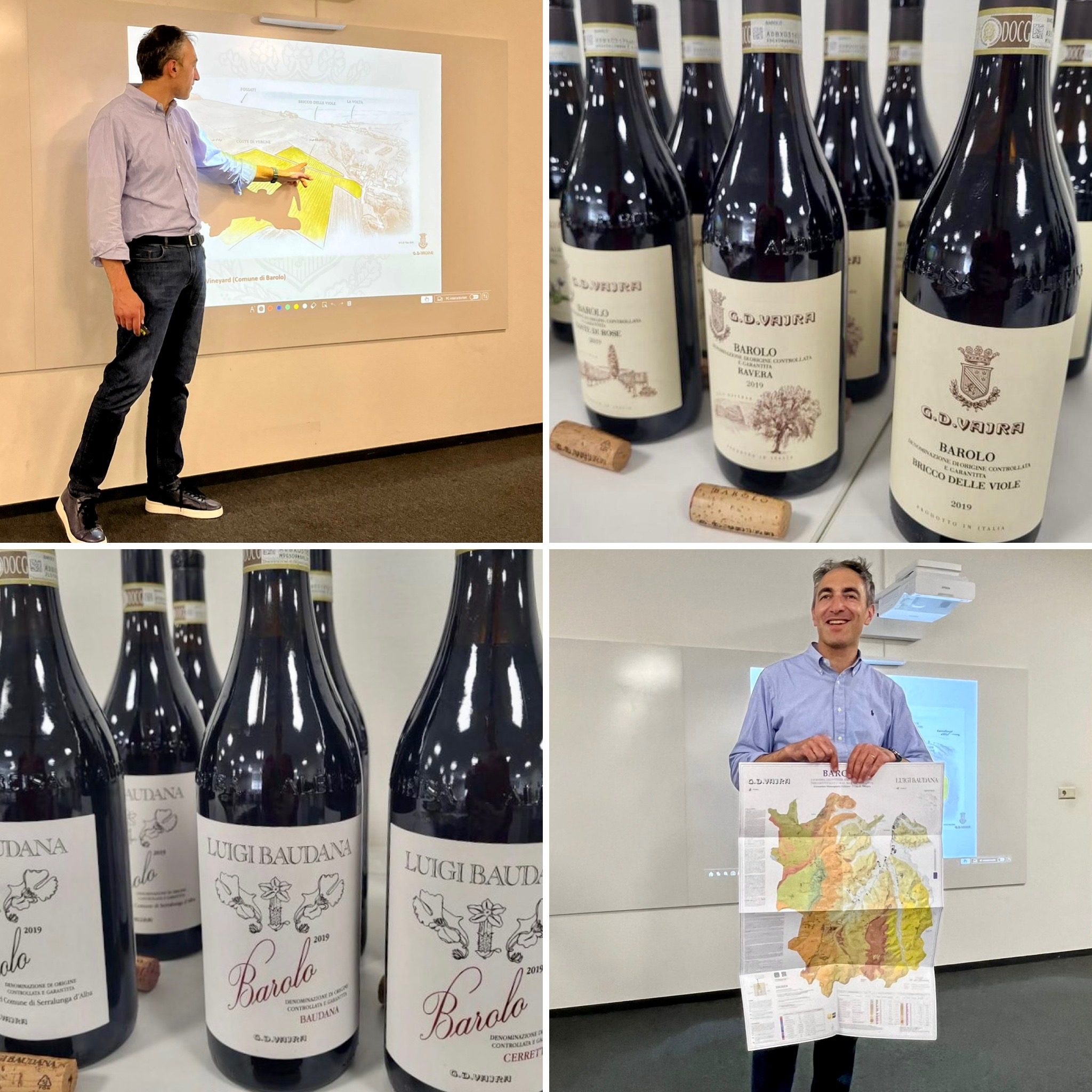Barolo by G.D. Vajra, the Voice of the Grape.
Barolo is one of the iconic wine regions of Italy, a region that has risen to absolute heights in the last decades, but has a history that well extends that. Home of the Nebbiolo grape, but no stranger to other varieties which its winemakers also embrace with passion and craftsmanship.
Recently Dutch importer Pallas Wines gave us the opportunity to sit down with one of the leading Barolo wineries, G.D. Vajra, and taste and discuss a selection of their wines. In this article we are sharing the highlights of this evening, and give way to Giuseppe Vaira to tell his story.
Traditional vs. Modern Winemaking in Barolo
When it comes to Barolo, it is common use to speak in terms of traditional versus modern winemaking. Traditionalism in the Piemonte sense of the word refers to traditional winemaking techniques, such as spontaneous fermentation at 30 degrees Celsius or more, long macerations and aging for three to five years in big Slavonian casks. Due to high and harsh tannins, traditional made Barolo usually is not easy to approach in its youth. Modernism in Barolo refers to richer and fruit-forward styles. Common used winemaking techniques are fermentations at lower temperatures, shorter macerations with punch-downs (or rotary fermenters) and aging in smaller (often new) oak barrels.
Nowadays the sharp edges of this dogmatic contradiction have been softened. One could say it is generally accepted that there is no absolute truth. Styles are converting and winemakers often do variate in the use of winemaking techniques.
If one would ask Giuseppe Vaira to pin-point G.D. Vajra, he probably will not answer that question straight away. Instead he presumably would share his deep thoughts about definitions and differences in interpretation. While he is taking you into his thoughts, it will become clear it is not only his permanent sceptic smile that is rebellious. G.D. Vajra is based on deep rooted and well-argued convictions.
Aldo Vaira
To understand what this is all about, we have to take a dive into history. Founded in 1971, G.D. Vajra is run by Aldo Vaira, his wife Milena and their children Giuseppe, Francesca en Isidoro. Although the winery is relatively young, its history is significant. In 1968 the fifteen years old rebellious student Aldo Vaira got caught at a political protest mars in Turin. His father Giuseppe Domenico – please not this are the initials in G.D. Vajra – took him back to the farm in Barolo and taught him the toughness of life by letting him do farmwork from dusk till dawn.
As always, blood is thicker than water. Aldo Vaira fell in love with farm and decided to become a farmer. His father agreed reluctantly, provided Aldo would finish his school. Studying and farming simultaneously earned him the nickname ‘The Professor’. As if those words were prophetic, Aldo Vaira ultimately became a respected viticulture professor and a proponent of organic farming in Barolo. It is that way that G.D. Vajra was the third winery to be certified organic in Barolo.
The Vajra Wine Family
After an insightful introduction our glasses were filled, and an impressive selection of the family’s wines found their way to our tables. Impressive in quality but also in terms of diversity.

Riesling
The determination of the Vaira family could not be more reflected than by the first wine to be served. This turns out to be a Riesling. Riesling clearly is not the first grape one would expect on a Barolo tasting. Giuseppe Vaira proudly reveals the story behind it. It started in 1985, just before the wedding day of Aldo and Milena Vaira. They were given the opportunity to buy a vineyard in Fossati and they bravely decided to spend their honeymoon savings to finance the purchase. The ink of their signatures had scarcely dried when the notary revealed a significant part of the vineyard would not be suitable for Nebbiolo. Undaunted by this setback, Aldo Vaira decided to plant the plot with a white variety. He decided to plant Riesling. It was Riesling he read about during his thesis about malolactic fermentation of white wines. Aldo and Milena Vaira never made their dream trip. Their Riesling however is one to dream about.
G.D. Vajra Riesling Pétracine 2022
In the nose distinguished stone fruit like green en red apple, white peach, candied lemon, lemon curd, white flowers and herbs like fennel and anise. Compact and linear on the attack, floating lush green herbaceous midpalate, crisp mouthwatering acids, tight powerful core, all fanning out to a floral and peppery aftertaste. Great gastronomic wine.
We award this wine with a 92-point DWA score.
Dolcetto
After the authentic Vajra Langhe Freisa Kyè 2020 (92-point DWA score) and surprisingly tough Pinot Nero (92-point DWA score) we tasted Dolcetto. Despite the saying that the veins of winemakers in Piemonte do contain more Dolcetto than blood, Dolcetto in Piemonte is losing ground in favour of Nebbiolo. As a forerunner on the use of less popular indigenous grapes, G.D. Giuseppe Vaira does not hide his discontent at this development. Where other winemakers transplanted Dolcetto from the top of the hills to lesser plots, G.D. Vajra Dolcetto saves the best spots for Dolcetto. We tasted the Dolcetto d’Alba Coste & Fossati. The grapes for this wine come from the vineyards “Coste di Vergne” and “Fossati” – close to the aforementioned Riesling spot – both historically dedicated to Nebbiolo. Apparently the saying ‘were a man usually is more careful of his money than of his principles’ does not apply to G.D. Vajra. The Dolcetto d’Alba Coste & Fossati of G.D. Vajra is a Dolcetto on a whole new level.
G.D. Vajra Dolcetto d’Alba Coste & Fossati 2021
The deep purplish wine does give sensational fresh and concentrated dark fruits like blueberry, wild bramble and subtle flowery and herbal notes. Concentrated fresh purple fruit like wild bramble and black cherry on the attack, velvety midpalate. Energetic, vibrant and elegant. Serious joy in the glass!
We award this wine with a 93-point DWA score.
Barbera
Although Vaira is sceptic about the lagging popularity of Dolcetto in favour of Barbera, it is not that G.D. Vajra is not serious about Barbera. G.D. Vajra is seen as one of the driving forces behind raise Barbara to great hights. According to Giuseppe Vaira, winemaking has to be like a clean window: “it is there, but you don’t see it”. It is about interpretating the grape, without covering it with the interpretation of the winemaker. Therefore, G.D. Vajra strives long extractions, avoiding the risk of over-extraction. During the fermentation process, the technique of submerged cap fermentation is commonly used. The submerged cap method keeps the cap under the surface of the must, avoiding contact with oxygen. This method promotes richer tannins and colour.
G.D. Vajra Barbera d’ Alba Superiore Viola delle Viole 2021
Deep purple, seductive aroma’s wild bramble, liquorice, wood floor and pepper. Pure and clean juice, gritty and grippy tannin structure and a long saline aftertaste. This really is an exciting one of a kind style of Barbera.
We award this wine with a 93-point DWA score.

Barolo
Continuous speaking in metaphors, Giuseppe Vajra compares the geology of Barolo to what he calls ‘the tiramisu accident’. Around 10 till 12 million years ago the Barolo region was a tropical sea, under witch soil sediments from the Alps were compressed to different layers (the tiramisu). 5 million years ago the sea dried out and the Alps tilted the soil layers; the horizontal layers turned vertical (the tiramisu accident), resulting in older soil layers in the east to younger soils in the west (the flipped over tiramisu).
We tasted three 2019 single vineyard Barolo’s of G.D. Vajra. Although the differences were remarkable, common denominator in the very young but already approachable wines was an unprecedented refinement and elegancy.
G.D. Vajra Barolo Coste di Rose 2019
Due to the fact the area around Coste di Rose once was the coastal area of the beforementioned tropical sea, this vineyard, which is close the city of Barolo, contains a high amount of sandstone (‘arenaria di diano’). The result is a light, etheric, perfumed style Nebbiolo with aromas of wild strawberry, ripe cherry, flowers and fresh herbs like mint. Delicate and floral with some ripe red fruits, ‘sandy’ tannins and a long saline aftertaste. According to Giuseppe Vaira, the Barolo Coste di Rose is the like the Beach Boys: light and charismatic and a lot of fun. We endorse this characterisation, but want to underline one should not think this Barolo is only frivolous. Underneath the levity hurks a perceptive and intelligent soul.
We award this wine with a 94-point DWA score.
G.D. Barolo Ravera 2019
Close to the city of Novello, the soil of the vineyard Ravera contains a high amount of oxidized red marlstone. This soil contributes to a more mature style Barolo. Although initially the wine shows some reduction, after a while it opens up en does give a sneak peek at its potential. This wine is tough and self-conscious. Relatively full bodied, excitingly well-structured and a long-lasting aftertaste. Even in its youth it is worth fighting the tannins, but patience will be rewarded. The Ravera pulls out all the strop and it is not without reason this wine is compared by Giuseppe Vaira by the loudness of the guitar work of Led Zeppelin.
We award this wine with a 94-point DWA score.
G.D. Vajra Barolo Bricco delle Viole 2019
Bricco delle Viole is located 450 meters above sea level. Where ripening of the grapes could be an issue in the past, in the context of climate change the height of the vineyard has turned out to be an advantage. Ripening no longer is a problem, and the diurnal range at this height brings sensational tension. This Barolo simultaneously is precise, refined and exciting. The wine gives the sensations of feminine seductiveness, combined with masculine structure and power. Or, in the word of Giuseppe Vajra: this Barolo is like Pink Floyd. It is harmonious symphonic, and rocks the shit out of you at the same time. Shine on you crazy diamond!
We award this wine with a 94-point DWA score.
G.D. Vajra – Luigi Baudana Barolo 2019
Last but not least we tasted a flight of three Luigi Baudana Barolo’s. Luigi Baudana is a small ‘garagist’ winery in Serralunga. G.D. Vajra produces the wines for Luigi Baudana since 2009. We tasted the Luigi Baudana Barolo del Comune di Serralunga d’Alba 2019, the Luigi Baudana Barolo Baudana 2019 and the Luigi Baudana Barolo Cerretta 2019.
Conclusion
Overviewing the whole spectrum, one would understand the reluctance of Giuseppe Vaira to pinpoint G.D. Vajra. At first, wine cannot be captured in a single definition. Furthermore, the style of G.D. Vajra is unique in every single way. When one would force us to put G.D. Vajra in a box, we would say G.D. Vajra is a modern driven traditional winery. Vajra does apply traditional winemaking techniques focusing on long extractions and long ripening. At the same time, G.D. Vajra has an inner drive to improve itself and the wines. Despite the youthness of the wines, they were al remarkable elegant and approachable.
According to Giuseppe his ultimate goal is to translate the voice of every grape in his wines. It is easy to pass this off as commercial claptrap, but based on the wines we tasted, we truly believe the Viara family is driven by this deeply rooted and well-argued conviction.
We thank G.D. Vajra and particularly Giuseppe Vajra for sharing the profound insights in Barolo. We thank Pallas Wines and especially Joep Speet and his team for organizing this masterclass.
This event was covered by our own Hermen Jansen. G.D. Vajra is imported in the Netherlands by Pallas Wines (part of Delta Wines) and available through selected retail and hospitality partners.

